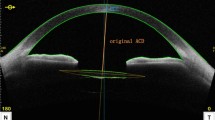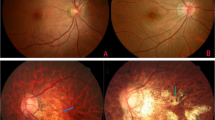Abstract
Purpose
To analyse the outcomes of phacoemulsification in extreme axial myopia
Methods
Consecutive cases of phacoemulsification in eyes with axial length ≥ 30.0 mm from January 1, 2010 to Dec 31, 2013 in a tertiary referral eye hospital were retrospectively reviewed. A single intraocular lens (IOL) type was used for all cases. Main outcome measures included perioperative complications and refractive outcome.
Results
Two hundred and twenty-one eyes were identified. Intraoperatively, two eyes (0.9 %) had unstable capsular bag and three (1.4 %) had posterior capsular rupture. At a mean follow-up duration was 27.4 ± 14.6 months, three eyes (1.5 % of 198 eyes with no history of retinal detachment or macular hole) developed retinal detachment. There was an overall hyperopic shift with a mean biometry error of 0.45 ± 1.21 D in all eyes. The mean absolute biometry prediction error was 0.98 ± 0.83 D in all eyes, 1.11 ± 0.86 D and 0.85 ± 0.82 D in eyes receiving negative- and positive-power IOL, respectively (p = 0.042). A total of 61.2 % of eyes had refractive outcome within ± 1.0 D of target spherical equivalent. Regression analysis showed low IOL power as an independent predictor for greater postoperative absolute biometry error (p = 0.014).
Conclusions
We showed no increase in perioperative complications in eyes with extreme high axial myopia. In eyes with long axial length, implantation of IOL with lower power was associated with more hyperopic shift, which was more pronounced with negative-power IOL.


Similar content being viewed by others
References
Fan DS, Lam DS, Lam RF, Lau JT, Chong KS, Cheung EY, Lai RY, Chew SJ (2004) Prevalence, incidence, and progression of myopia of school children in Hong Kong. Invest Ophthalmol Vis Sci 45:1071–1075
Grossniklaus HE, Green WR (1992) Pathologic findings in pathologic myopia. Retina 12:127–133
Tano Y (2002) Pathologic myopia: where are we now? Am J Ophthalmol 134:645–660
Narendran N, Jaycock P, Johnston RL, Taylor H, Adams M, Tole DM, Asaria RH, Galloway P, Sparrow JM (2009) The Cataract National Dataset electronic multicentre audit of 55,567 operations: risk stratification for posterior capsule rupture and vitreous loss. Eye (Lond) 23:31–37. doi:10.1038/sj.eye.6703049
Petermeier K, Gekeler F, Messias A, Spitzer MS, Haigis W, Szurman P (2009) Intraocular lens power calculation and optimized constants for highly myopic eyes. J Cataract Refract Surg 35:1575–1581. doi:10.1016/j.jcrs.2009.04.028
Holladay JT (2004) Visual acuity measurements. J Cataract Refract Surg 30:287–290. doi:10.1016/j.jcrs.2004.01.014
Lyle WA, Jin GJ (1996) Phacoemulsification with intraocular lens implantation in high myopia. J Cataract Refract Surg 22:238–242
Fan DS, Lam DS, Li KK (1999) Retinal complications after cataract extraction in patients with high myopia. Ophthalmology 106:688–691. doi:10.1016/s0161-6420(99)90152-5, discussion 691–682
Zuberbuhler B, Seyedian M, Tuft S (2009) Phacoemulsification in eyes with extreme axial myopia. J Cataract Refract Surg 35:335–340. doi:10.1016/j.jcrs.2008.10.044
Haug SJ, Bhisitkul RB (2012) Risk factors for retinal detachment following cataract surgery. Curr Opin Ophthalmol 23:7–11. doi:10.1097/ICU.0b013e32834cd653
Daien V, Le Pape A, Heve D, Carriere I, Villain M (2015) Incidence, risk factors, and impact of age on retinal detachment after cataract surgery in France: a national population study. Ophthalmology 122:2179–2185. doi:10.1016/j.ophtha.2015.07.014
Lin JY, Ho WL, Ger LP, Sheu SJ (2013) Analysis of factors correlated with the development of pseudophakic retinal detachment--a long-term study in a single medical center. Graefes Arch Clin Exp Ophthalmol 251:459–465. doi:10.1007/s00417-012-2043-3
Ripandelli G, Scassa C, Parisi V, Gazzaniga D, D’Amico DJ, Stirpe M (2003) Cataract surgery as a risk factor for retinal detachment in very highly myopic eyes. Ophthalmology 110:2355–2361. doi:10.1016/s0161-6420(03)00819-4
Coppe AM, Lapucci G (2008) Posterior vitreous detachment and retinal detachment following cataract extraction. Curr Opin Ophthalmol 19:239–242. doi:10.1097/ICU.0b013e3282fc9c4a
Neuhann IM, Neuhann TF, Heimann H, Schmickler S, Gerl RH, Foerster MH (2008) Retinal detachment after phacoemulsification in high myopia: analysis of 2356 cases. J Cataract Refract Surg 34:1644–1657. doi:10.1016/j.jcrs.2008.06.022
Shen P, Zheng Y, Ding X, Liu B, Congdon N, Morgan I, He M (2013) Biometric measurements in highly myopic eyes. J Cataract Refract Surg 39:180–187. doi:10.1016/j.jcrs.2012.08.064
Berges O, Puech M, Assouline M, Letenneur L, Gastellu-Etchegorry M (1998) B-mode-guided vector-A-mode versus A-mode biometry to determine axial length and intraocular lens power. J Cataract Refract Surg 24:529–535
Olsen T, Nielsen PJ (1989) Immersion versus contact technique in the measurement of axial length by ultrasound. Acta Ophthalmol (Copenh) 67:101–102
Findl O, Kriechbaum K, Sacu S, Kiss B, Polak K, Nepp J, Schild G, Rainer G, Maca S, Petternel V, Lackner B, Drexler W (2003) Influence of operator experience on the performance of ultrasound biometry compared to optical biometry before cataract surgery. J Cataract Refract Surg 29:1950–1955
Hennessy MP, Franzco, Chan DG (2003) Contact versus immersion biometry of axial length before cataract surgery. J Cataract Refract Surg 29:2195–2198
Zaldivar R, Shultz MC, Davidorf JM, Holladay JT (2000) Intraocular lens power calculations in patients with extreme myopia. J Cataract Refract Surg 26:668–674
Tsang CS, Chong GS, Yiu EP, Ho CK (2003) Intraocular lens power calculation formulas in Chinese eyes with high axial myopia. J Cataract Refract Surg 29:1358–1364
Haigis W (2009) Intraocular lens calculation in extreme myopia. J Cataract Refract Surg 35:906–911. doi:10.1016/j.jcrs.2008.12.035
Preussner PR (2010) Intraocular lens calculation in extreme myopia. J Cataract Refract Surg 36:531–532. doi:10.1016/j.jcrs.2009.10.038, author reply 532–534
Barrett GD (1993) An improved universal theoretical formula for intraocular lens power prediction. J Cataract Refract Surg 19:713–720
Olsen T (2007) Calculation of intraocular lens power: a review. Acta Ophthalmol Scand 85:472–485. doi:10.1111/j.1600-0420.2007.00879.x
Abulafia A, Barrett GD, Rotenberg M, Kleinmann G, Levy A, Reitblat O, Koch DD, Wang L, Assia EI (2015) Intraocular lens power calculation for eyes with an axial length greater than 26.0 mm: comparison of formulas and methods. J Cataract Refract Surg 41:548–556. doi:10.1016/j.jcrs.2014.06.033
Chong EW, Mehta JS (2015) High myopia and cataract surgery. Curr Opin Ophthalmol. doi:10.1097/icu.0000000000000217
The Royal College of Ophthalmologists (2010) Cataract Surgery Guidelines. London. https://www.rcophth.ac.uk/wp-content/uploads/2014/12/2010-SCI-069-Cataract-Surgery-Guidelines-2010-SEPTEMBER-2010.pdf.Accessed 12 Jan 2016
Day AC, Donachie PH, Sparrow JM, Johnston RL (2015) The royal college of ophthalmologists’ national ophthalmology database study of cataract surgery: report 1, visual outcomes and complications. Eye (Lond) 29:552–560. doi:10.1038/eye.2015.3
Jaycock P, Johnston RL, Taylor H, Adams M, Tole DM, Galloway P, Canning C, Sparrow JM (2009) The Cataract National Dataset electronic multi-centre audit of 55,567 operations: updating benchmark standards of care in the United Kingdom and internationally. Eye (Lond) 23:38–49. doi:10.1038/sj.eye.6703015
Lundstrom M, Behndig A, Kugelberg M, Montan P, Stenevi U, Thorburn W (2011) Decreasing rate of capsule complications in cataract surgery: eight-year study of incidence, risk factors, and data validity by the Swedish National Cataract Register. J Cataract Refract Surg 37:1762–1767. doi:10.1016/j.jcrs.2011.05.022
Author information
Authors and Affiliations
Corresponding author
Ethics declarations
Funding
No funding was received for this research.
Conflict of interest
All authors certify that they have no affiliations with or involvement in any organization or entity with any financial interest (such as honoraria; educational grants; participation in speakers’ bureaus; membership, employment, consultancies, stock ownership, or other equity interest; and expert testimony or patent-licensing arrangements), or non-financial interest (such as personal or professional relationships, affiliations, knowledge or beliefs) in the subject matter or materials discussed in this manuscript.
Ethical approval
All procedures performed in studies involving human participants were in accordance with the ethical standards of the institutional and/or national research committee and with the 1964 Helsinki declaration and its later amendments or comparable ethical standards. For this type of study formal consent is not required
Informed consent
Informed consent was obtained from all individual participants included in the study.
Rights and permissions
About this article
Cite this article
Lam, J.K.M., Chan, T.C.Y., Ng, A.L.K. et al. Outcomes of cataract operations in extreme high axial myopia. Graefes Arch Clin Exp Ophthalmol 254, 1811–1817 (2016). https://doi.org/10.1007/s00417-016-3414-y
Received:
Revised:
Accepted:
Published:
Issue Date:
DOI: https://doi.org/10.1007/s00417-016-3414-y




